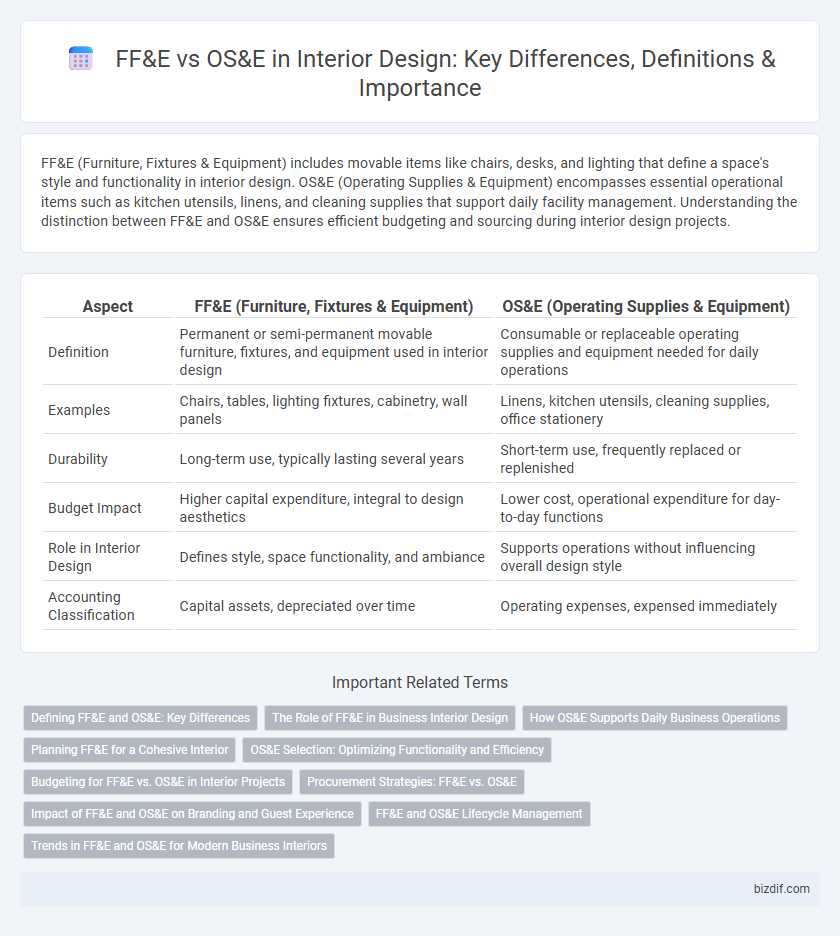FF&E (Furniture, Fixtures & Equipment) includes movable items like chairs, desks, and lighting that define a space's style and functionality in interior design. OS&E (Operating Supplies & Equipment) encompasses essential operational items such as kitchen utensils, linens, and cleaning supplies that support daily facility management. Understanding the distinction between FF&E and OS&E ensures efficient budgeting and sourcing during interior design projects.
Table of Comparison
| Aspect | FF&E (Furniture, Fixtures & Equipment) | OS&E (Operating Supplies & Equipment) |
|---|---|---|
| Definition | Permanent or semi-permanent movable furniture, fixtures, and equipment used in interior design | Consumable or replaceable operating supplies and equipment needed for daily operations |
| Examples | Chairs, tables, lighting fixtures, cabinetry, wall panels | Linens, kitchen utensils, cleaning supplies, office stationery |
| Durability | Long-term use, typically lasting several years | Short-term use, frequently replaced or replenished |
| Budget Impact | Higher capital expenditure, integral to design aesthetics | Lower cost, operational expenditure for day-to-day functions |
| Role in Interior Design | Defines style, space functionality, and ambiance | Supports operations without influencing overall design style |
| Accounting Classification | Capital assets, depreciated over time | Operating expenses, expensed immediately |
Defining FF&E and OS&E: Key Differences
FF&E (Furniture, Fixtures & Equipment) refers to tangible assets like desks, chairs, and lighting installed in interior spaces that are movable yet essential to the design and function of a room. OS&E (Operating Supplies & Equipment) encompasses items used daily to support operations, such as linens, kitchenware, and cleaning supplies, which are consumable or frequently replaced. Key differences lie in FF&E's role as fixed or semi-fixed physical design elements versus OS&E's focus on operational, consumable goods critical for facility maintenance and service delivery.
The Role of FF&E in Business Interior Design
FF&E (Furniture, Fixtures & Equipment) plays a crucial role in business interior design by shaping the aesthetic appeal and functionality of commercial spaces, directly influencing employee productivity and customer experience. Carefully selected FF&E items, such as ergonomic office chairs, modular desks, and branded fixtures, contribute to creating an environment that supports operational efficiency and reinforces brand identity. Unlike OS&E, which encompasses consumable operating supplies, FF&E represents permanent assets that define the workspace's long-term comfort, style, and usability.
How OS&E Supports Daily Business Operations
Operating Supplies & Equipment (OS&E) includes essential items such as linens, kitchenware, and office supplies that facilitate smooth daily operations in hospitality and commercial interiors. OS&E supports employee efficiency and enhances guest experience by ensuring all consumables and small equipment are readily available and properly maintained. Unlike FF&E, which shapes the aesthetic and structural environment, OS&E directly impacts operational functionality and service delivery.
Planning FF&E for a Cohesive Interior
Effective planning of FF&E (Furniture, Fixtures & Equipment) ensures a cohesive interior by selecting pieces that balance aesthetics with functionality, creating a unified design theme throughout the space. Prioritizing coordination among furniture styles, materials, and finishes enhances spatial harmony and supports the intended ambiance. Integrating FF&E thoughtfully with OS&E (Operating Supplies & Equipment) optimizes both visual appeal and operational efficiency in interior design projects.
OS&E Selection: Optimizing Functionality and Efficiency
OS&E selection focuses on optimizing functionality and efficiency by prioritizing durable, easy-to-maintain items that support daily operations and enhance user experience. Emphasizing ergonomic design and adaptability, OS&E includes products like kitchenware, linens, and cleaning supplies that directly impact workflow and service quality. Strategic OS&E choices improve operational productivity and reduce long-term replacement costs, essential for sustainable interior design in hospitality and commercial spaces.
Budgeting for FF&E vs. OS&E in Interior Projects
Budgeting for FF&E (Furniture, Fixtures & Equipment) in interior projects requires allocating resources for durable, long-term assets like seating, lighting, and cabinetry, which significantly influence the design's aesthetic and functionality. OS&E (Operating Supplies & Equipment) budgeting focuses on consumable, frequently replaced items such as kitchen utensils, linens, and cleaning supplies, impacting operational efficiency and maintenance costs. Accurate cost forecasting for FF&E involves detailed vendor quotes and installation expenses, whereas OS&E budgeting demands ongoing expense tracking to ensure replenishment aligns with operational needs.
Procurement Strategies: FF&E vs. OS&E
Effective procurement strategies for FF&E prioritize durability, brand consistency, and design compatibility to enhance the overall aesthetic and long-term value of interior spaces. OS&E procurement focuses on cost-efficiency, functionality, and timely replenishment to support daily operational needs and maintain service quality. Strategic sourcing for FF&E involves bulk purchasing and vendor partnerships, while OS&E requires agile inventory management and frequent supplier communications to adapt to dynamic usage patterns.
Impact of FF&E and OS&E on Branding and Guest Experience
FF&E and OS&E play crucial roles in shaping brand identity and enhancing guest experience within interior design; FF&E elements like furniture and fixtures establish the visual aesthetics and comfort that define a space's appeal, while OS&E items such as linens and kitchen tools ensure operational efficiency and guest satisfaction. Thoughtful integration of FF&E aligns with brand values and creates memorable environments, whereas well-curated OS&E supports seamless service and influences the perceived quality of the experience. Both categories contribute to a cohesive design strategy that reinforces brand loyalty and drives positive guest perceptions.
FF&E and OS&E Lifecycle Management
FF&E (Furniture, Fixtures & Equipment) and OS&E (Operating Supplies & Equipment) possess distinct lifecycle management processes critical to interior design projects. FF&E lifecycle management involves procurement, installation, maintenance, and planned replacement of durable items such as furnishings and built-in fixtures, ensuring long-term functionality and aesthetic consistency. OS&E lifecycle management focuses on managing consumable and operational supplies, emphasizing inventory control, replenishment, and cost efficiency throughout the property's operational lifespan.
Trends in FF&E and OS&E for Modern Business Interiors
Trends in FF&E for modern business interiors emphasize sustainable materials, modular designs, and smart technology integration to enhance functionality and aesthetic appeal. OS&E trends focus on ergonomic office supplies, energy-efficient appliances, and advanced organizational tools that streamline operations and improve employee well-being. Together, these elements create adaptable, efficient, and eco-friendly work environments tailored to evolving business needs.
FF&E (Furniture, Fixtures & Equipment) vs OS&E (Operating Supplies & Equipment) Infographic

 bizdif.com
bizdif.com